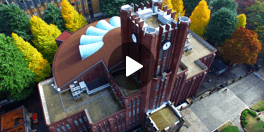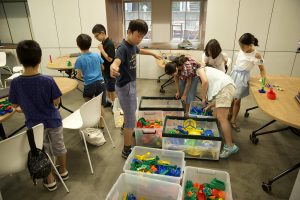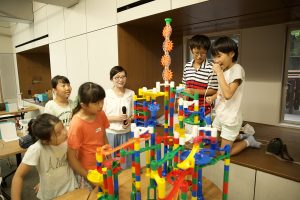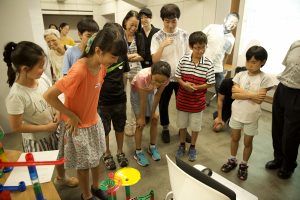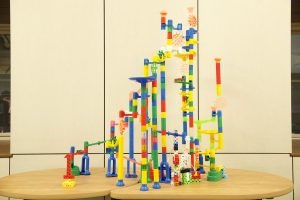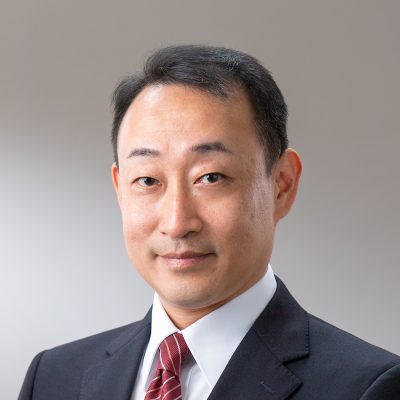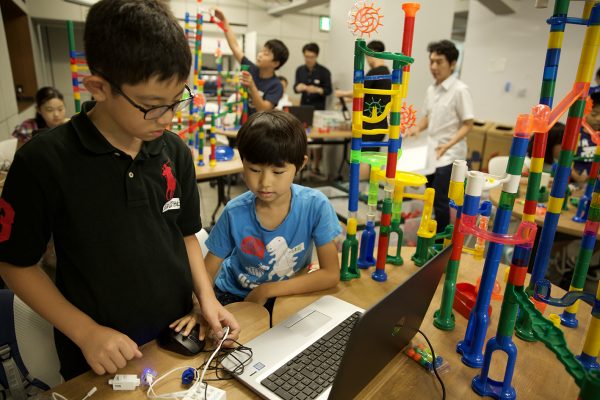
September 20, 2018
挑戦!ロボットプログラミング!Robot Programming Challenge
2018年8月2日と3日の二日間、情報学環オープンスタジオにて小学生を対象としたロボットプログラミングワークショップを開催しました。
今回で2回目となるこのワークショップは、文京アカデミー夏休み子どもアカデミアの1イベントとして実施され、文京区内の小学校に通う小学4年生から6年生の子たちが参加しました。このワークショップでは、「もし◯◯ならば、△△するデジタルマーブルマシン」をテーマに、ボールが転がる装置であるマーブルマシンをチームごとに自由制作してもらいました。
当日のプログラム
1. 自己紹介
2. チーム分け・マーブルマシンの説明
3. マーブルマシン作り
4. ロボットプログラミングの練習
5. 休憩
6. チームごとに作戦会議
7. デジタルマーブルマシン作り(途中で中間発表を行った)
8. 作品発表会
9. ふりかえり
はじめに、ロボットプログラミングを用いない普通のマーブルマシンを自由に作ってもらい、次に子ども向けのロボットプログラミングキットとパソコンを使って、センサーやモータの使い方を練習した後、ロボットプログラミングを用いたデジタルマーブルマシンを自由制作してもらいました。
今回は、デジタルマーブルマシンを作る前に、同じチームの参加者同士でどんなものを作るのかを相談する「作戦会議」の時間を設けました。初対面の参加者同士で次第に打ち解けていく様子や、アイデアを出し合う様子、学生スタッフにも相談する様子が見られました。
自由制作の時間では、参加者同士で楽しそうにマーブルマシンを組み立てる様子や、センサーやモーターの使い方やプログラミングについて調べる様子が伺えました。ボールがマーブルマシンから落ちてしまったりロボットが上手く動かなかったりする部分を何度も調整して、どうなったら成功するのかを参加者同士で議論する様子もありました。なかなか上手くいかなかったところが成功したときは参加者の小学生はもちろん、大人まで一緒になって喜び、会場は大変盛り上がりました。
ワークショップの最後には、チームごとに作品発表とデモンストレーションを行ってもらいました。どのチームの作品にも個性があり、面白い仕掛けが施されていました。
今回のワークショップでも小学生たちが自由な発想を活かして楽しみながら作品作りに取り組む姿が見られ、有意義な場となりました。
作品の動画は中山未来ファクトリーYouTubeチャンネルからご覧いただけます。
記事:阪口紗季(特任研究員)
On August 2 to 3, 2018, a robot programming workshop for elementary school students was held at the Open Studio, iii UTokyo.
This was the second such workshop and this time was held as an event of the Bunkyo Academy Summer Vacation Children’s Academy. Children from the fourth grade to the sixth grade of elementary school in Bunkyo-ku participated. Each team was asked to make a marble machine, which is a device that rolls balls, on the theme of “if something happens, the digital marble machine does something.”
Program of the day
1. Introduction
2. Teaming up and description of the marble machine
3. Making a marble machine
4. Practicing robot programming
5. Break
6. Strategy meeting for each team
7. Making a digital marble machine (including intermediate presentation)
8. Presentation
9. Reflection
First of all, participants made ordinary marble machines without using robot programming. They then practiced using sensors and motors with robot programming kits and personal computers, and made digital marble machines using robot programming.
This time, before making a digital marble machine, time was set aside for ‘strategy meetings’ where participants in the same team could consult with each other about what kind of things they would make. Participants gradually opened up to each other, presented ideas, and also talked with the student staff.
During the time for making marble machines, participants happily assembled marble machines and learned how to control sensors and motors by programming. There were also times when participants discussed how to succeed when the ball dropped from the marble machine or the robot did not move properly. When the marble machine succeeded, not only the participants but also the adults were pleased, creating much excitement.
At the end of the workshop, each team presented their work and gave demonstrations. Each team’s work had its own personality and interesting gimmicks.
The workshop was a meaningful place where elementary school students exercised free thinking and took pleasure in the process of creation.
A movie showing the products of the workshop can be seen on Nakayama Future Factory’s YouTube channel.
Text: Saki Sakaguchi (Project researcher)
Proofreading: David Buist (Project senior specialist)
主担当教員Associated Faculty Members
教授
苗村 健
- 先端表現情報学コース
- 情報学環教育部
Professor
NAEMURA, Takeshi
- Emerging design and informatics course
- Undergraduate research student program

